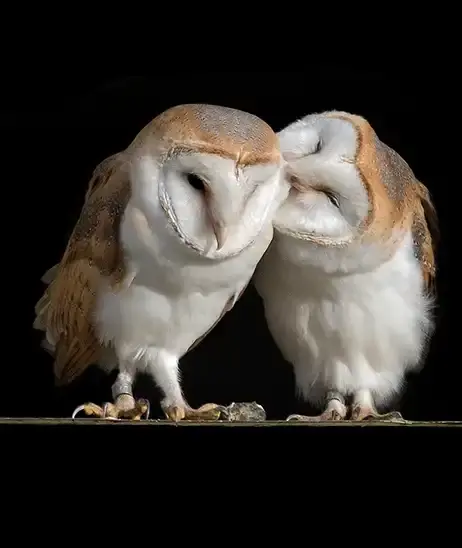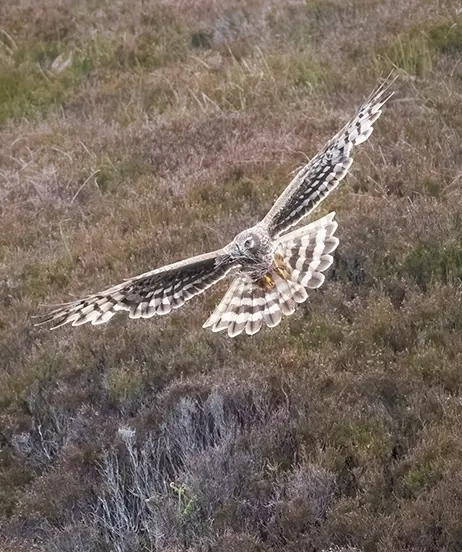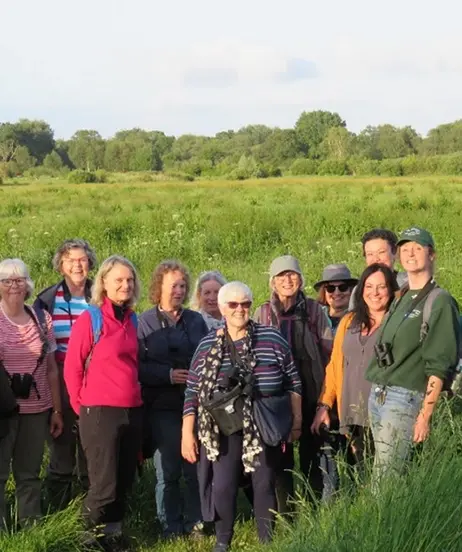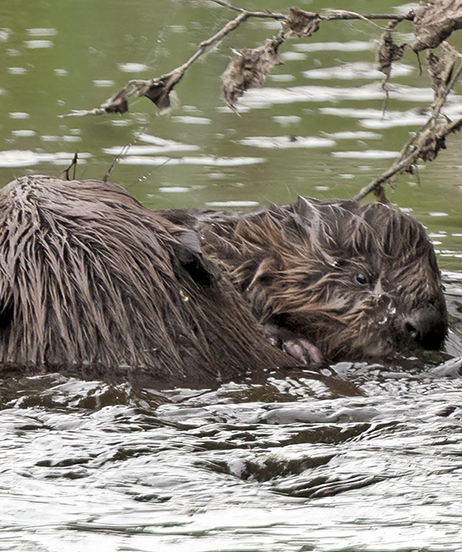
Give the Gift of Conservation This Christmas: The Hawk and Owl Trust’s Innovative Nest Box Sponsorships Ideal for Nature Enthusiasts
17 December 2024: For over 30 years, The Hawk and Owl Trust has been aiding raptor conservation with its pioneering Adopt a Box scheme, first launched in 1993. This impactful initiative has provided safe nesting environments for some of Britain’s most iconic birds of prey, including Barn Owls, Tawny Owls, Little Owls, Kestrels, and Peregrines, across seven regions of Great Britain making a great gift for the nature enthusiasts in your life this Christmas.
“Approximately 80% of Barn Owl couples now nest in boxes provided through programmes like ours,” says Chris Sperring MBE, Conservation Officer at The Hawk and Owl Trust. “This sponsorship offers a tangible way to support conservation efforts while connecting people with the incredible wildlife in our countryside. Each sponsorship includes a personalised certificate of sponsorship, a yearly activity report, a greeting card with your message, a detailed guide to British Owls or Raptors and a bespoke The Nest Box newsletter filled with updates of the conservation efforts.”
Over the past few years, the Hawk and Owl Trust has instigated a major program of installing updated nest boxes and replacing older ones to meet growing conservation needs. The Trust’s innovative designs now feature enhanced predator protection, weather resistance, and materials that mimic natural nesting sites. These improvements have significantly increased occupancy and breeding success rates, ensuring raptors have safe and effective nesting environments.
Why Sponsor a Nest Box?
Sponsorship directly supports conservation efforts and helps ensure the survival of birds of prey and owls in Britain. Through public sponsorships, the programme funds the installation, monitoring, and maintenance of bespoke nesting boxes, designed specifically to meet the needs of each species.
Perfect Gift for Nature Lovers
The Adopt a Box sponsorship is an ideal gift for any occasion—Christmas, birthdays, or even as a meaningful gesture for yourself. Sponsors can choose a box in one of seven regions across the UK and select their preferred bird species.
Making a Difference
Funds raised through the Adopt a Box scheme support the Trust’s licensed Wildlife Conservation Officers, who monitor the boxes during breeding seasons and provide expert advice to landowners. This collaborative approach ensures the longevity and health of local bird populations while fostering greater awareness of the importance of raptor conservation.
To find out more about gifting an Adopt a Box this Christmas visit: https://hawkandowltrust.org/how-to-support/join-us/adopt-a-box

Brood Management of Hen Harriers Update
The Hawk and Owl Trust (HAOT) has long worked with landowners to develop balanced conservation strategies. In late 2014, HAOT formed a scientific advisory committee with three leading academics (Professors Ian Newton, Steve Redpath, and Des Thompson) to guide them on the Hen Harrier’s situation in upland England.
Prof Steve Redpath, a committee member, stressed the importance of evidence-based solutions:
“Finding solutions that work for all sides depends on solid evidence. Relying only on enforcement risks worsening the conflict and possibly further reducing harrier numbers. This would harm both the Hen Harrier and those who enjoy seeing these birds. Surely it’s better to build a plan based on evidence and dialogue rather than trying to force one view?”
Following this advice, HAOT backed DEFRA’s 2016 Hen Harrier Action Plan and Trial. A key part was the Brood Management Trial, which involved taking eggs or chicks from some Hen Harrier nests on grouse moors, raising them in captivity, and then releasing them back into northern England’s uplands.
The Trust’s support came with conditions, including safe satellite tagging of all released birds and a promise to end support if any illegal harm occurred.
Project Outcomes
The 2023 Hen Harrier survey shows mixed results. In 2023, a total of 54 nests were recorded (up from 49 in 2022) of which 36 were successful (34 in 2022). A total of 141 Hen Harrier chicks fledged (119 in 2022). This is a huge increase from just four pairs in 2016. Yet, Hen Harriers are still missing from large areas.
It is widely acknowledged that the illegal killing of Hen Harriers must come to an end. An alternative strategy has been implemented and is showing signs of success, as evidenced by the increasing population numbers. However, the rate of mortality and the disappearance of these birds within their first year remains high.
The Hawk and Owl Trust’s Involvement
As the current licence period ends, the HAOT board has reviewed the charity’s involvement. The Trust knew its participation was a calculated risk but believed its voice could make an impact. While some members had reservations, the Trust felt this project was more important than these concerns.
The Trust earlier this year has reassessed its role based on the project’s outcomes and the latest scientific evidence available. It remains committed to finding practical solutions that balance wildlife protection with human needs, always guided by the best available data and expert advice.
The board recognised that Hen Harrier Brood Management has been controversial, drawing criticism from nature lovers and gamekeepers alike.
HAOT hasn’t directly carried out the initiative but has played a supportive role, offering insights and backing evidence-based solutions to balance wildlife conservation with human interests.
The charity acknowledges the programme’s successes, including more Hen Harrier nests and breeding pairs in England. However, the project has faced challenges and legal issues. Both environmentalists and estate managers have raised concerns, highlighting the project’s sensitive nature.
Despite population growth, Hen Harrier numbers remain low, with illegal culling still a problem. Budget constraints limited the research team’s ability to fully assess the Action Plan’s impact on bird populations, underscoring the need for proper funding in wildlife research and also areas which are no longer managed.
Illegal harm to Hen Harriers and weak law enforcement remain serious issues requiring a multi-faceted approach.
The Trust decided in March 2024 to withdraw from the project at the end of the current licence period and focus on other conservation efforts.
The Trust recognises the ongoing need for collaboration, transparency, and monitoring to ensure the Hen Harrier’s survival. Future success depends on licences, funding, and cooperation between conservationists, land managers, and stakeholders, building on the foundation laid by the initiative.

‘Well Woman Walks’ at Shapwick Moor
20 September 2024 – The Hawk and Owl Trust is inviting local women to connect with nature through dedicated monthly ‘Well Woman Walks’ at Shapwick Moor Nature Reserve, near Glastonbury, Somerset. The initiative aims to benefit mental wellbeing and provides women with an opportunity to connect with nature, stay active, and enjoy the beauty of the local surroundings.
Recognising the need for specific programmes that support women’s wellbeing and access to nature, the Hawk and Owl Trust began offering the regular walks in early 2023 to provide a safe, supportive environment for women of all ages and fitness levels. The walks take place on the last Monday of each month, with space for up to 15 walkers each session. Past walks have centred on specific themes, offering an introduction to different aspects of the natural world, such as wildlife gardening and nocturnal critters. Walkers are invited to stay and wind down with a hot drink after the session.
Nestled in the Somerset Wetlands National Nature Reserve, Shapwick Moor is part of a fascinating working landscape celebrated for its rich wildlife, heritage and culture. The Hawk and Owl Trust manage this former arable farmland for the benefit of birds of prey and other wildlife.
The walks are led by Alex Learmont, Shapwick Moor Nature Reserve Warden & Outreach Officer at the Hawk and Owl Trust, who commented: “The Well Woman Walks at Shapwick Moor began in 2023 after several local women approached me expressing a desire to engage more deeply with the nature reserve and its unique wildlife. They wanted a supportive environment to start this journey, and we listened. Our walks have since evolved into a cherished escape – a safe space where women can leave behind daily pressures, connect with each other, and immerse themselves in the calming surroundings at Shapwick Moor as we look out for seasonal highlights.
“Many of our participants find these walks to be a breath of fresh air, a respite from their roles as caregivers or from other challenging life circumstances. Research suggests that UK women are three times more likely than men to feel unsafe in a park during the day. Our Well Woman Walks are more than just a walk; it’s a chance to share stories, gain strength from shared experiences, and simply feel safe to enjoy a peaceful moment in nature,” continued Alex.
Julie Slater, a regular attendee of the Well Woman Walks, commented: “Attending the Well Woman Walks every month is something that I always look forward to – it gives me the opportunity to learn more about nature and the magnificent wildlife that the reserve has to offer. It also gives me a chance to do something for myself with like-minded women. I always come away with a smile on my face, eagerly awaiting the next walk.”
Warden’s Walks – new monthly walks open to all
Starting this autumn, Hawk and Owl Trust will also be running monthly 'Warden's Walks' at Shapwick Moor, giving visitors the chance to experience the reserve's wildlife as it changes through the seasons. The next walk will take place on Friday 11 October.
Wildlife sightings – What to expect
In late summer and early autumn, walkers can look forward to a rich tapestry of plants bearing fruits and nuts and wildlife species at Shapwick Moor, from Hobbies and Woodpeckers, to Kestrels and Kingfishers, lots of fungi, and a few late dragonflies and butterflies.
What to bring
Visitors are encouraged to dress for the weather, sturdy walking boots or wellies recommended. Binoculars are also recommended to fully experience the wonders that the reserve has to offer.
The walk will take in a mixture of hardstanding track and grassy fields, with mostly level ground. There is a wooden footbridge and a stile on one of the footpaths, as well as several uneven concrete steps.
To sign up for the next Well Woman Walk, please visit: https://members.hawkandowltrust.org/Event-Registration/EventId/68

‘The Kingdom of the Ice Bear’ – fundraising event for Sculthorpe Moor Nature Reserve, Norfolk – 27 September 2024
16 September 2024 – A local wildlife photographer and volunteer reserve warden is set to share his captivating account of an extraordinary Arctic expedition at an upcoming fundraising event for the Hawk and Owl Trust’s Sculthorpe Moor Nature Reserve on the outskirts of Fakenham, Norfolk.
‘The Kingdom of the Ice Bear’ is the story of Bob Johnson's four-week voyage on a historic seal hunting boat in the Arctic, photographing polar bears up-close. Setting sail in the summer of 2018, Bob’s journey took him deep into the remote fjords of Northern Svalbard and up to the polar icecap, where he faced freezing temperatures, rugged conditions, and breathtaking encounters with polar bears. His talk will add extra colour to his stunning photographs with anecdotes of life onboard the Havsel – Norway’s last seal hunting vessel and the same boat now mainly used by the BBC to film iconic nature documentaries like Frozen Planet.
A trip to Africa in 2006 sparked Bob’s passion for wildlife photography. Over the years, he has travelled to more than 50 countries, capturing the world’s most incredible species, and was recently named PAGB’s ‘Wildlife Photographer of the Year’ 2024.
Visitors to Sculthorpe Moor might recognise Bob as one of the reserve’s friendly, dedicated volunteer wardens. Since retiring to North Norfolk in 2023, Bob has spent most Fridays at the reserve, topping up bird feeders, helping to maintain the hides, and chatting with visitors about the site’s abundant wildlife.
Bob Johnson said, “I’ve been giving talks to photographers about my travels for years, but this is a special chance to share my Arctic adventure with my local community. I’m very lucky to have Sculthorpe Moor right on my doorstep. My photography has taken me everywhere from the Serengeti to the polar icecap, but I still find immense joy in the diverse array of local Norfolk wildlife that can be spotted on the reserve such as the Barn Owl, the Marsh Harrier, and my favourite, the Kingfisher. It’s an honour to use my experiences to help raise funds for this amazing place.”
Victoria Chamberlin, Education and Activities Officer at Sculthorpe Moor Nature Reserve, said: “Bob is not only a talented photographer but also a dedicated volunteer warden who plays an important role in helping visitors get the most out of their time on the reserve. His upcoming talk is another example of that. Bob’s stunning photographs and stories offer a glimpse into a world few of us will ever experience first-hand, but also a reminder that you don’t need to travel far to connect with nature.”
Proceeds from ‘The Kingdom of the Ice Bear’ event will directly support the Hawk and Owl Trust’s conservation projects at Sculthorpe Moor Nature Reserve, helping to maintain and expand its work in protecting Norfolk’s wildlife.
Tickets to Bob’s talk at Sculthorpe Moor Nature Reserve on Friday, 27 September cost £10 and can be purchased from https://members.hawkandowltrust.org/Event-Registration/EventId/108.
Public donations are essential to supporting the Trust’s work. People can also become members to stay updated on new exciting projects and announcements.

Discovery Days at Sculthorpe Moor Nature Reserve, Fakenham – Wednesdays, 10am-12.30pm
29 July 2024 – Local families and visitors to Norfolk can get closer to nature this summer with a range of low-cost ‘drop-in’ activities on offer throughout the school holidays at the Hawk and Owl Trust’s Sculthorpe Moor Nature Reserve in Fakenham, North Norfolk.
Running every Wednesday from July 24th to August 28th from 10am to 12:30pm, the ‘Discovery Days’ summer holiday programme will include a range of interactive and educational activities aimed at connecting children and adults with the natural world. Visitors will be able to explore the wonders of nature through pond-dipping, bug hunts, woodland activities, nature crafts, guided bird watching and an intriguing nature trail, all facilitated and led by the reserve’s dedicated activities staff and volunteers. While the Discovery Days are particularly suited to primary school-aged children (3-11 years), children and teenagers of all ages are welcome to join the fun.
Each Discovery Day is £6 per participating child with accompanying adults free of charge. These are drop-in events so there is no booking needed. The Sculthorpe site is fully accessible and can accommodate the specific needs of children.
Participants will also have access to the entire 200-acre nature reserve for the rest of the day, allowing families to explore its beauty at their own pace. Visitors are welcome to bring their own packed lunch and enjoy picnicking in a serene natural setting.
"The Discovery Days are a fantastic opportunity for families to immerse themselves in the wonders of nature in this vibrant corner of Norfolk as they unwind from a busy school year," says Victoria Chamberlin, Education and Activities Officer at Sculthorpe Moor Nature Reserve.
"Our goal is to provide children and their families with memorable experiences that foster a lifelong love and appreciation for the natural world. With a variety of low-cost, accessible activities and resources available throughout the summer, there’s something for everyone to enjoy."
Look, listen, touch: self-guided sensory trail and family resources available daily
With Sculthorpe Moor open daily to visitors throughout the year, the Discovery Days are just one of the many ways in which families and individuals can explore the reserve this summer. New to Sculthorpe this summer are interpretation boards dotted around the reserve, offering a sensory exploration of the self-guided family trail while learning more about the fantastic wildlife to be found along the way.
The ever-popular ‘spotter sheets’ will also be available for free from the visitor centre to keep children engaged and enhance their learning as they try to spot some of the reserve’s varied species of birds, mammals, amphibians and insects.
Wildlife at Sculthorpe
Visitors to Sculthorpe Moor Nature Reserve this summer will be able to experience the beauty of the varied pond life, including stickleback fish, newts, dragonflies, butterflies and damson flies, and have the chance to spot creatures nestled in the reserve’s meadow, wood, fen and wetland habitats, such as frogs, wild fowl, egrets and kingfishers.
About Sculthorpe Moor Nature Reserve
The Sculthorpe Moor Nature Reserve, located near Fakenham in the Wensum Valley in North Norfolk, welcomes visitors to 200 acres dedicated to the conservation of wildlife, with seven hides across a range of managed landscapes, including meadow, wood, fen and wetlands habitats. The conservation site is open all year round from 9 am – 4 pm daily.
To plan your visit to Sculthorpe Moor nature reserve, visit: https://sculthorpe.hawkandowltrust.org/

- Three beaver kits spotted at Sculthorpe Moor Nature Reserve in Fakenham, Norfolk this week, becoming the latest addition to the reserve’s resident beaver family
- The original pair were introduced to the site in 2022 as part of a 5-year biodiversity project led by the Hawk and Owl Trust
07 June 2024 – Three beaver kits have been caught on camera at the Hawk and Owl Trust’s Sculthorpe Moor Nature Reserve in Norfolk this week.
The playful newcomers join their two older siblings, born last year to the Eurasian beaver pair introduced to the reserve in 2022 as part of a project to enhance biodiversity and encourage more birds of prey to take up residence at the site.
Beavers were hunted to extinction in the UK in the 16th century for their fur, meat, and even the oil from their scent glands. Efforts to reintroduce the species over the past few decades mean England’s beaver population now stands at around 500. The arrival of the three youngsters brings Fakenham’s count to seven.
Adrian Blumfield, Operations Director at the Hawk and Owl Trust, which manages Sculthorpe Moor Nature Reserve, says: “The arrival of the three kits is a hugely positive sign for the health of the reserve’s ecosystem and a boon for the UK’s beaver population.
“While the beavers are most active at dawn and dusk, making daytime sightings less frequent, our volunteer monitoring wardens have compiled some incredible video footage of the kits exploring the world around them, splashing around in the water and even working together to build a new dam. Watching these amazing creatures interact with each other and their environment is a truly exceptional experience. We welcome all visitors to join us at Sculthorpe Moor Nature Reserve during our daily opening hours of 9am-4pm to learn more about beavers and the vital role they play in supporting a rich tapestry of wildlife.”
How beavers are helping to grow numbers of birds of prey
Beavers are herbivores, living on a plant-based diet consisting of a wide range of bark, shoots, leaves and roots. They fell trees for food but also to use as building materials for constructing their dams and lodges.
Beaver foraging opens up woodland canopy, allowing more light to reach the ground, promoting the growth of a diverse range of plant species. The increased plant diversity creates more food and shelter for insect-eating birds, bats, amphibians and other small creatures, while the deadwood left on land and in water provides shelter for many species from their predators.
In Nature, the fine connections that exist between all organisms are what help maintain balance. Plants and animals in a community are linked by what they eat or what gives them energy.
Raptors – such as hawks, owls, eagles and falcons – are at the top of the food chain and play a key role in their ecosystems. When populations of birds of prey go down, the numbers of their prey species go up, creating an imbalance in the ecosystem.
The Beavers and Biodiversity Gain Project
The Beavers and Biodiversity Gain Initiative was established to tackle this disparity. Spearheaded by the Hawk and Owl Trust, the initiative secured funding from the Green Recovery Challenge Fund, which is part of the government's post-pandemic efforts, alongside public contributions.
The creation of the beaver enclosure and woodland has led to an increase in the number of raptors on site and initial signs show an increase in biodiversity.
About Beavers
With their stocky builds and long tails, the Eurasian Beaver is Britain's largest rodent and the world’s second largest. They are semi-aquatic mammals, sporting thick brown fur, long orange teeth for gnawing, and webbed back feet for swimming. Beavers are thought to mate for life. They live in small family groups and tend to have a litter of two to four babies – or kits – each year. The young beavers stay with their parents for about two years before venturing out to establish their own homes.

